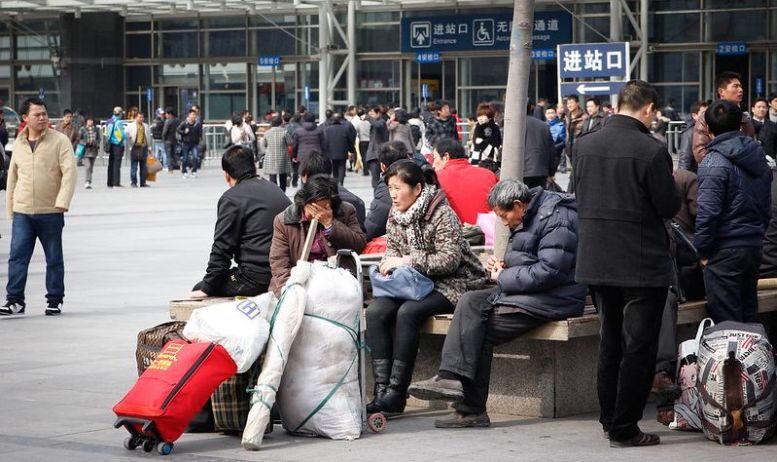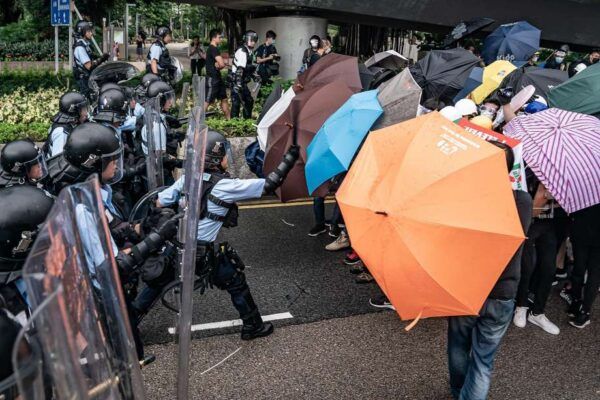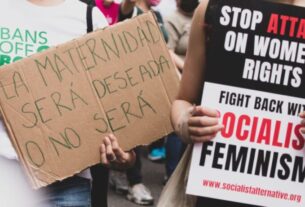The economy is tipping into a deflationary crisis with a worsening debt crunch, falling wages and prices, and increasing reliance of fraudulent economic data.
The word ‘involution’ or neijuan describes ever increasing inputs that produce no improvements. Think of trying to run up a down escalator. This term has gained mass usage in China since 2020, along with others like ‘lying flat’ (tang ping). They express revulsion at the brutal capitalist rat race in a society where infants receive coaching in order to pass an interview for a kindergarten place.
Involution can also be used to describe many features of China’s economy as its epic multifaceted crisis worsens. The property market, by far the biggest in the world, has collapsed. Last year, housing construction fell to 40 percent of its 2020 level. Still, there are staggering levels of oversupply.
Japanification
Calculating the excess housing stock by subtracting all the residential floor space sold from the total built, reveals enough empty homes to accommodate 150 million people (almost 5 billion square meters at the end of 2023). This figure is just the tip of a very big iceberg. It does not include all the second and third homes bought as ‘investments’ during the decades-long housing bubble.
Of China’s roughly 300 million urban households, one-third own more than one home and 10 percent own more than two homes. As house prices crash, falling much more steeply than the official data shows, these second and third homes are increasingly being put up for sale, further saturating the market and fueling deflation (falling prices).
The latter is now causing sleepless nights in global financial markets and — we would presume — in Zhongnanhai (the government compound in Beijing). Deflation is seen as the most urgent of China’s “four D’s”: debt, deflation, decoupling and demographics. Deflation in China does not officially exist. Last year the government warned economists not to discuss it. But like other capitalist economic phenomena, it stubbornly and subversively defies the suppression attempts of the so-called Communist Party (CCP).
In December, prices fell at their steepest rate for 14 years. Economists warn that China is facing its most prolonged bout of deflation since the so-called Asian Crisis of 1997–98. This risks becoming entrenched — a vicious circle whereby collapsing property values, falling wages and unemployment translate into even weaker demand, forcing factories to lower prices and cut wages even more. Deflation is disastrous for highly indebted economies like China, because as prices fall, old debts become more costly to service in real terms. China’s debt has grown from $2.1 trillion USD in 2001 to $47.5 trillion USD in 2023.
The Marxist website chinaworker.info has explained that China’s economy has entered a phase of ‘Japanification’, but also pointed out that China’s crisis could actually out-Japan Japan in several respects. This is because China is bigger, poorer, and more fragile in social, regional and economic terms.
Pivot to manufacturing
The housing meltdown has led state-owned banks and local governments to pivot away from the property sector and to promote investment in manufacturing, especially in the ‘new three’ industries: electric vehicles (EV), lithium-ion batteries and solar cells.
This strategy has partly been encouraged by the central government as part of the CCP’s state capitalist economic model. But as always in China, different wings of the state compete against each other in an uncoordinated, unplanned free-for-all. The result is more overcapacity. This happened in property. It is now being replicated in the disorderly expansion of the new energy sector. While outstanding bank loans to the property sector actually contracted last year, banks extended almost 5 trillion yuan of new loans to the manufacturing sector in Q3 alone.
Superficially this looks impressive. But it’s another example of involution. Banks are funding this expansion because they need to generate new loans to offset all the dud loans (loans that will never be paid back) tied to the sinking ship of the property market. Local governments likewise need to keep their own economic wheels turning with alternative projects, as the property crash deflates local economies, crushes consumer demand, and aggravates their own debt crisis. Local governments across China are piling into the new three industries like a gold rush. In January, Beijing officials warned of “blind investments” causing monster levels of overcapacity in these sectors. There are more than 600,000 EV companies, with an increase of 40 percent in 2022 alone (239,400 new companies). Most of these companies will fail — EV sales in China have already begun to fall. Thus, the cycle of debt-financed overcapacity is being replicated once more. A government crackdown is coming.
China’s manufacturing sector output is contracting (for four consecutive months). Overcapacity, which drives price wars and deflation, is already extreme. China’s capacity in solar module production (900 GW) is three times greater than projected global demand (300 GW) according to a December 2023 report from the Economist Intelligence Unit. Its capacity in EV batteries is forecast to reach almost four times total global demand by 2027.
At the same time, China’s domestic market is not expanding. Despite its unparalleled dominance in solar energy, this only accounted for 4.7 percent of China’s electricity generation in 2022, with fossil fuels accounting for 70 percent.
These stark figures illustrate the absurdities of capitalism, which has reached a dead-end as a global system. Capitalism, based on private ownership of the means of production and nation states, both of which play a completely reactionary and economically suffocating role, cannot harness this increased productive capacity from China as part of an existentially urgent green transition. Instead, global capitalism erects protective walls, increasingly citing “national security,” with Xi Jinping’s regime and the US attempting to outdo each other.
The lack of demand in China’s home market means manufacturing companies have become even more dependent on foreign demand. Last year, this accounted for 57 percent of manufacturing activity. But exports are being squeezed by the weak global economy and geopolitics (the US-China Cold War). China’s exports measured in US dollar terms fell 4.6 percent in 2023 (to $3.38 trillion USD) compared to the year before.
This year, the global picture looks even darker. The one bright area of China’s economy, EV and automotive exports, is likely to encounter growing pushback by foreign governments. Last year, China overtook Japan to become the world’s top vehicle exporter (shipping 4.14 million passenger cars overseas versus Japan’s 3.98 million).
But in October, the European Union launched an “anti-subsidy” investigation into China’s EV exports, which it fears will overrun the continent’s homegrown automotive giants like Volkswagen and Renault. The verdict of this investigation is due at the end of 2024 and could kick off a major new trade war. Firing a warning shot, the Chinese regime launched an “anti-dumping” probe into French cognac on 5 January. The Macron government in France is seen as a prime mover behind the EU’s investigation.
Meanwhile, it is election year in the US. Currently, former president Donald Trump is ahead of Joe Biden in most polls. Even without a Trump victory in November, anti-China rhetoric is likely to soar from both the Democratic and Republican camps as the election race heats up.
In the era before today’s imperialist power struggle between China and the US, China-bashing by US presidential candidates was largely a performance and would not translate into real policies. But the world has changed. New sanctions, financial controls and trade protectionism against China are not only possible, but likely. Governments in the US and European Union are not the only ones erecting walls against Chinese exports. India has imposed tariffs on Chinese solar modules. And Turkey has slapped a 40 percent extra tariff on Chinese EVs.
Falling wages
2023 was a disastrous year for the economy and for Xi Jinping’s regime. 2024 is already shaping up to be worse. China has not been rocked by major protests since the short-lived 2022 movement. These protests were crushed by a wave of arrests but not before bringing about the collapse of Xi Jinping’s brutal zero-COVID policy. From this it would be wrong to conclude that China is politically “stable”, that the masses have been “pacified”.
Beneath the surface discontent is greater than ever. The authority of the CCP regime has fallen precipitously among all social classes. Not only the capitalist class but probably a majority of the population regard the official data and economic propaganda of the CCP as a bad joke.
Officially, China achieved GDP growth of 5.2 percent growth last year. This would be the lowest growth since 1976 with the exception of two pandemic years (2020 and 2022) but even this figure is fraudulent. It is an obvious case of data that has been manipulated for propaganda purposes. This lack of reliable economic data makes accurate analysis impossible. But how do the CCP’s figures square with the fact of the collapse of the property market? This sector still accounts for 23 percent of total economic output, down from 30 percent three years ago.
In contrast, the “new three” industries account for just 3.5 percent of total economic output. As The Economist magazine (7 December, 2023) noted: “Even if the ‘new three’ together were to expand by 20 percent a year, they cannot add as much to growth in the next few years as the property downturn will subtract from it.”
And as this mouthpiece of the global capitalists pointed out: “The new three as a group are also not as labour-intensive as property, which generates a useful mixture of blue-collar jobs (builders) and white-collar careers (estate agents and bankers).”
In other words, China’s unemployment crisis is set to get worse. The above comparison shows the fundamentally contradictory basis of the regime’s claim of “5.2 percent” growth. Rhodium Group, a research firm, estimated the actual growth figure was around 1.5 percent in 2023. Convincingly, it argued the official GDP data was, “irreconcilable with evidence of general malaise and reactive policymaking that has piled up all year long.”
Therefore, even the international capitalist institutions are increasingly calling out Beijing’s fake data. Chinese people reached this conclusion much sooner. Many will say there is no economic growth and in fact the economy is “driving in reverse.” According to Zhu Tian, economics professor at China Europe International Business School in Shanghai, quoted by Reuters (18 January): “We’re in a recession. If you talk to 10 people, seven will say we’ve had a bad year.”
Wages are down across almost the whole economy. Even in the “booming” EV and solar sectors there have been several disputes over layoffs and unpaid wages. Meanwhile in the traditional (fuel engine) vehicle sector mass layoffs have begun. Migrant workers are giving up and returning to their home provinces in record numbers. Falling real incomes, rather than the hazy concept of low “confidence,” is the main factor depressing consumer demand in China.
The problem of insufficient demand is “severe,”, with “zero growth in the past three years” according to Yao Yang, director of Peking University’s National School of Development, quoted in the South China Morning Post (20 January). He and many other Chinese economists advocate “demand-side reforms” such as direct subsidies to consumers, as practised in many Western economies and also in Hong Kong, as opposed to the CCP’s current stimulus measures that ramp up manufacturing capacity despite the market already reaching its limits. In previous articles, we have explained why the CCP regime is especially wary of this type of “demand-side” stimulus.
Hundreds of supermarkets including at big chains like Carrefour and BBK closed down last year due to the recession in the retail sector. The local government debt crisis has also led to widespread cuts in pay and bonuses for government employees and dozens of protests over unpaid wages.
According to online recruitment platform Zhaopin, salaries in 38 major cities fell by an average of 1.3 percent during the final quarter of 2023. This was the third consecutive quarter of wage contraction. In Beijing, wages decreased 2.7 percent from a year ago and in Guangzhou by 4.5 percent, this report showed. Wages for young people and graduates fell more steeply.
War on ‘negative news’
This reality is airbrushed out of the regime’s propagandized economic data. Embarrassing economic statistics, such as for youth unemployment, are hit with gag orders. In December, the government resumed issuing unemployment data for youth (16–24 year-olds) after six months of censorship, reporting a rate of 14.9 percent. But it had changed the methodology to exclude students, many of whom extend their studies only because they cannot find jobs.
There is a long tradition of manipulated economic data in China. The late Li Keqiang, who was China’s premier from 2013 to 2023, famously said the country’s GDP data was unreliable and “man-made.”. Oxford Economics, a UK company, says China’s real GDP could be 20 percent smaller than te published figures.
The gap between official GDP data and reality has grown wider since 2020. Xi’s regime needs to project an alternative reality of economic strength both to face down external threats (deepening geopolitical disputes) and internal ones (power struggles within the state and possible outbreaks of mass unrest). Chinese people are now bombarded with what the economist Eswar Prasad calls “unrealistically positive rhetoric.”
As the crisis has deepened in the past three years, the state’s control of economic information has become more extensive. In December, Weibo (China’s equivalent of Twitter) warned account holders not to spread negative reports about the economy. Several prominent economic commentators including Liu Jipeng and Hong Rong have been erased from social media.
This propaganda and censorship campaign has further undermined the regime’s authority among the public. Online mockery has forced the CCP authorities to delete several of their own propaganda articles. On 2 February, an article on People’s Daily online, the CCP’s flagship newspaper, drew so many derisory comments its related hashtag was removed. This was an interview with a visiting politician from a small Maoist party in Germany, Renate Koppe, who made the absurd claim that “the whole country is filled with an air of optimism.”
Also deleted was a 2016 article predicting that China would join the club of “high-income” nations by 2024 — the People’s Daily complained it was “maliciously shared” by a Weibo user who wrote this would “brighten up my Lunar New Year’s celebration.”
Chain of crisis
The Japan-style implosion of China’s housing bubble began three years ago. The next link in the chain of crisis was local governments, whose massive debt problems became public knowledge last year. By the second half of 2023, the crisis had spread to the shadow banking sector, with its deep connections to the property sector and the off-balance-sheet investment vehicles of local governments. This was shown by the failure of several trust companies including Zhongzhi, a giant of the sector, which filed a bankruptcy and liquidation application in a Beijing court on 5 January.
The court filing revealed Zhongzhi’s total assets amounted to just 200 billion yuan against liabilities of up to 460 billion yuan. Shadow finance refers to companies that engage in riskier forms of lending at higher interest rates and conduct their business outside the traditional banking sector. As such they are not regulated to the same extent. More upheavals in this sector are likely in the coming year.
The next link in China’s chain of crises could be the traditional banking sector. A full-blown financial crisis can no longer be excluded in the period ahead. In the past year we have seen several regional banks taken over or bailed out by the biggest state-owned banks on orders from the CCP. This is especially in Henan, Inner Mongolia and Liaoning, provinces badly hit by the property meltdown. There are reports that the big state banks are increasingly unwilling to play this role, with their own balance sheets under strain.
Previously, we and many other commentators placed a lower likelihood on a 2008 US-style financial collapse. This is because the greater extent of government control of the banking system means they can absorb much greater financial losses by shuffling these from one corner of the system to another in a continuous financial juggling act. But the longer and deeper the current Japan-style implosion becomes, the more difficult this juggling act becomes for China’s financial authorities.
Recent developments suggest growing panic behind the scenes. These include the merger of three of China’s so-called asset management companies (these “assets” are in fact debts, piled up from previous bailouts) with the Sovereign Wealth Fund, China Investment Corporation, which commands $1,350 billion USD in assets. The merger could point to mounting losses buried inside these entities. This is just one part of what seems to be a major shake-up in the central finance authorities, to assert more centralized control, which was signalled by Xi Jinping at last year’s NPC.
National team is back
Recent policies to revive China’s virtually stone-dead stock market are further signs that something serious is afoot. On 7 February, Yi Huiman was dismissed as chairman of the China Securities Regulatory Commission (CSRC) and replaced with Wu Qing. Yi’s sacking was the third in a row for the heads of the CSRC, all of whom were made scapegoats for the stock market’s colossal losses.
Wu’s appointment was accompanied by a raft of government announcements of new stimulus measures including a reported 2 trillion-yuan fund to prop up the stock market, which has halved in value since 2019 (with losses of 42 trillion yuan). Thus, the national team, made famous in the 2015–16 market and currency crisis, is again being mobilized to put a “floor” under stocks.
But this time around things are different. The slide on the stock market reflects a broader deflationary crisis arising from the collapse of the property bubble. It is aggravated by a collapse in belief among investors that Xi Jinping and his economic team can solve the economic crisis. 2015 was closer to a classical stock market “correction” following a period of runaway financial speculation.
The CCP seems to view the plunging stock market not only as an additional economic threat, reinforcing deflationary pressures, but as a “stability question” with possible political impacts. “Marshalling so much capital smacks of desperation and makes me wonder if policymakers are worried [that] perhaps some big institutions are at risk of huge losses,” commented Bill Bishop of Sinocism.
A sign of paralysis at the top is the long delay in convening the CCP’s Third Plenum, which should have taken place at the end of 2023. So far, no date has been announced. Third Plenums occur twice per decade and are traditionally used by the regime to unveil major new economic policies. The mystery of the Third Plenum suggests serious divisions within the regime, or possibly a fear that if the meeting showcases a lack of “new ideas” this will itself further compound the economic crisis.
A shaky base
The economic crisis is eroding the base of the CCP regime. The mass protest wave of 2022 was the first lightning flash of mass discontent which can again in the next period spill onto the streets. Under today’s rapidly worsening economic conditions, including a truly desperate situation for young people, it is likely that the next outbreaks of protest, whenever they happen, will combine demands for political change with a multitude of economic grievances.
If the CCP-state responds with an iron fist — its default position — this could under certain conditions provoke an even bigger counter-response. Xi’s personalised dictatorship, seen by his own circle as the only way to save CCP rule from internal decomposition and revolution, risks triggering these very outcomes.
Because all protest is illegal, workers’ strikes are repressed, and any form of non-CCP political organisation is outlawed, the Chinese dictatorship lacks the flexibility of “democratic” capitalist regimes. These have a number of institutional ‘shock absorbers’ such as a more open media and social media, at least the formal existence of “opposition” political forces, which can (not always and not forever) retard the development of political crises into full-blown revolutionary challenges.
Due to the gigantic road block of dictatorship, any new wave of mass struggle can acquire revolutionary features in China, as happened in 1989, once this passes that decisive point at which the fear of police repression loses its grip on the masses.
In a survey conducted in East Germany soon after the Berlin Wall came down, three-quarters of respondents said they had not seen it coming. A key outcome of the “white paper” protests in 2022 was that many participants said they had not realised before this that so many others shared their anger against existing conditions. China is moving into a period of shocks and unforeseen developments as the rule of the CCP increasingly loses its way.




